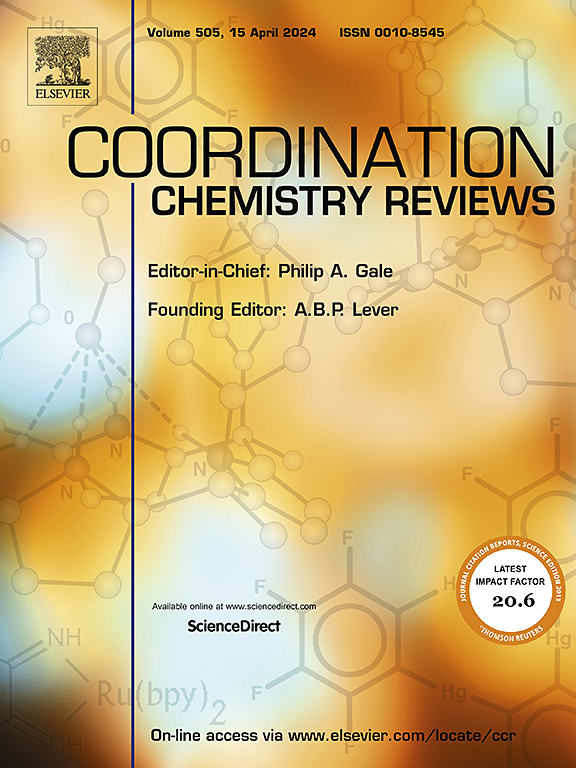合理设计钴基共价有机框架(COFs)电催化剂,优化其能量转换应用
IF 23.5
1区 化学
Q1 CHEMISTRY, INORGANIC & NUCLEAR
引用次数: 0
摘要
广泛的兴趣已经显示在设计有效的,负担得起的和生态良性的电催化剂的能量转换应用。为了解决日益增长的能源需求,近几十年来,人们设计了几种新型电催化剂。特别是,共价有机框架(COFs)已成为电催化的潜在候选者,因为它们具有多孔和晶体结构,内在的协调金属离子或宿主金属纳米颗粒(NPs)的能力。具有不同拓扑结构和集成的离散微孔和/或介孔的多边形晶格可以通过将有机构建块结合到耐用的、有规则组织的二维和三维聚合物中作为分子支架来构建。对基本建筑单元和框架的预先规划、选择和修改提供了多种结构,这些结构在电催化中具有不同的、可设计的性能。随着高效COF催化剂,特别是过渡金属(TM)掺杂材料的设计和开发的迅速推进,在促进氮还原反应(NRR)、析氢反应(HER)、氧还原反应(ORR)、析氧反应(OER)和二氧化碳还原反应(CO2RR)方面取得了重大进展。此外,钴掺杂COFs (Co-COFs)由于其可调的结构、高表面积和优异的催化活性而被认为是电催化应用的有希望的候选者。Co-COFs较低的化学和热稳定性可能会影响其长期的电催化性能。此外,实际应用中的缩放问题源于它们合成的费用和复杂性。此外,还需要更多的研究来充分了解它们的结构-性能相关性。在此,我们重点介绍了钴掺杂COFs的设计原则、有效的合成策略和结构修饰方面的最新进展。此外,我们比较和讨论了Co-COFs的关键示例及其在选定的能量转换应用中的性能。最后,提出了设计和开发高性能电催化剂的挑战和未来展望,以实现不同的能量转换应用。本文章由计算机程序翻译,如有差异,请以英文原文为准。
Rationally design and modulation strategies of cobalt-based covalent organic frameworks (COFs) electrocatalysts towards energy conversion applications
Widespread interest has been shown in the design of effective, affordable and ecologically benign electrocatalysts for energy conversion applications. To resolve the growing energy demand, several types of new electrocatalysts have been designed in recent decades. In particular, covalent organic frameworks (COFs) have been emerged as a potential candidate for electrocatalysis due to their porous and crystalline structure, intrinsic ability to coordinate metal ions or host metal nanoparticles (NPs). Polygonal lattices with distinct topology and integrated discrete micropores and/or mesopores could be constructed by incorporating organic building blocks into durable, regularly organized two- and three-dimensional polymers as molecular scaffolding. Pre-planning, selection and modification of both the basic building units as well as the framework provide a multitude of structures with diverse, designable properties useful in electrocatalysis. With the rapid advancements in designing and developing highly efficient COF catalysts, particularly transition metal (TM)-incorporated materials, significant progress has been made in facilitating the nitrogen reduction reaction (NRR), the hydrogen evolution reaction (HER), oxygen reduction reaction (ORR), oxygen evolution reaction (OER), and carbon dioxide reduction reaction (CO2RR). In addition, cobalt incorporated COFs (Co-COFs) have been considered as promising candidate for electrocatalytic applications owing to their tuneable architectures, high surface area, and exceptional catalytic activity. Long-term electrocatalytic performance may be impeded by the low chemical and thermal stability of Co-COFs. Furthermore, scaling problems for practical applications arise from the expense and complexity of their synthesis. Moreover, more research is necessary to fully comprehend their structure-performance correlations. Herein, we highlight current advancements in design principles, effective strategies of synthesis and structural modifications of cobalt-incorporated COFs. Furthermore, we compare and discuss key examples of Co-COFs and their performance towards selected energy conversion applications. Finally, remaining challenges and future perspectives for designing and developing high performance electrocatalysts have been provided for diverse energy conversion applications.
求助全文
通过发布文献求助,成功后即可免费获取论文全文。
去求助
来源期刊

Coordination Chemistry Reviews
化学-无机化学与核化学
CiteScore
34.30
自引率
5.30%
发文量
457
审稿时长
54 days
期刊介绍:
Coordination Chemistry Reviews offers rapid publication of review articles on current and significant topics in coordination chemistry, encompassing organometallic, supramolecular, theoretical, and bioinorganic chemistry. It also covers catalysis, materials chemistry, and metal-organic frameworks from a coordination chemistry perspective. Reviews summarize recent developments or discuss specific techniques, welcoming contributions from both established and emerging researchers.
The journal releases special issues on timely subjects, including those featuring contributions from specific regions or conferences. Occasional full-length book articles are also featured. Additionally, special volumes cover annual reviews of main group chemistry, transition metal group chemistry, and organometallic chemistry. These comprehensive reviews are vital resources for those engaged in coordination chemistry, further establishing Coordination Chemistry Reviews as a hub for insightful surveys in inorganic and physical inorganic chemistry.
 求助内容:
求助内容: 应助结果提醒方式:
应助结果提醒方式:


